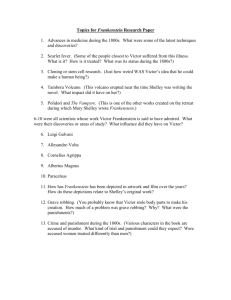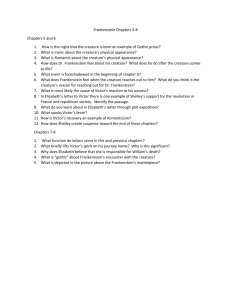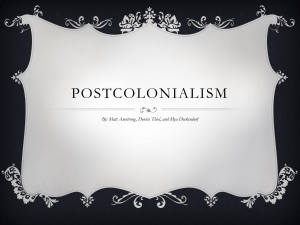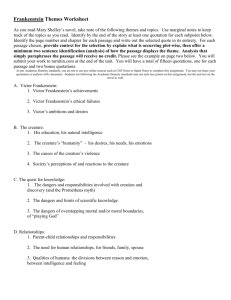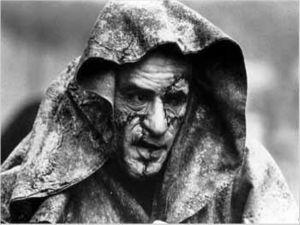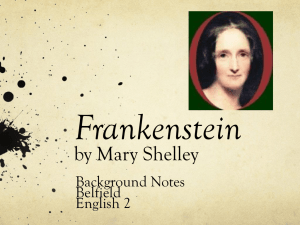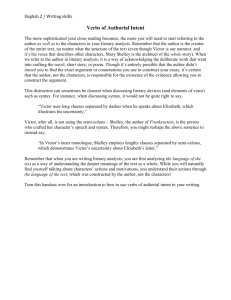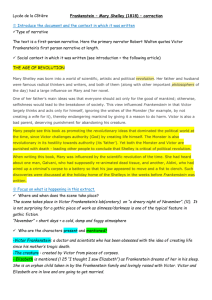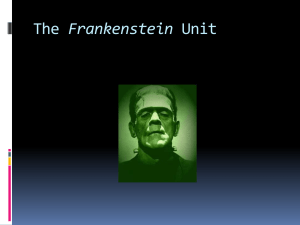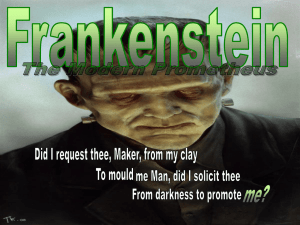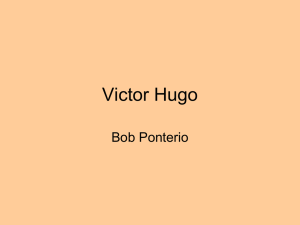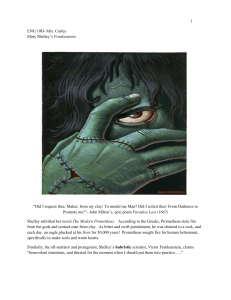Frankenstein
advertisement
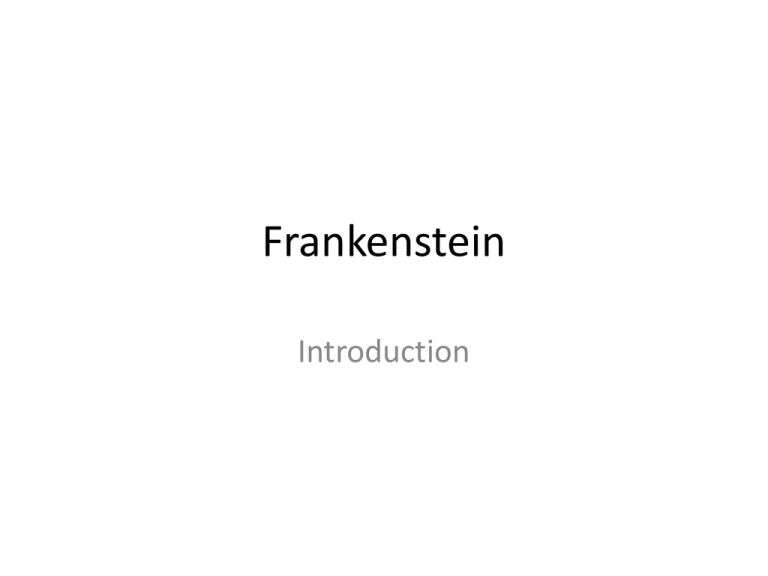
Frankenstein Introduction Life and Times of Mary Shelley • Born Mary Wollstoncraft (William Godwin and Mary Wollstoncraft – both liberal writers) • 1797 • Mother wrote “A Valediction on the rights of Woman” (feminist • Lived in Scotland in teen years (wrote) • Returned to London at 16 • • • • • • Met and fell in love with Percy Bysshe Shelley Had affair and became pregnant Married after his wife committed suicide Lost 3 children Percy drowned in 1822 At 24 she was an impoverished widow – supported herself with her writing • Frankenstein published in 1818 (20 yrs old) • Considered a feminist text (written by daughter of a feminist) – yet has very few strong female characters Historical Events • 1789: French Revolution (common people trying to get rid of monarchy) – very bloody • 1793-1794: French Reign of Terror (Robespierre) – British lost all hope for true justice and equality • 1804: Napoleon is crowned Emporer Romantic Writers • Turned towards nature as an escape from the harsh realities of their world • Nature was a place where human tyranny did not reign. Romantic Movement • Disheartened liberals • Sought solitude in nature, believing that the key to all emotional healing could be found in nature • Nature imagery is the most predominant feature – Ie. The weather was fine: it was about the middle of August…the weight upon my spirit was sensibly lightened as I plunged into the precipices that overhung me on every side – the sound of the river raging among the rocks, and the dashing of the waterfalls around, spoke of a power mighty as Omnipotence – and I ceased to fear, or to bend before any less almighty than that which had created and ruled the elements… • The idea of disenfranchised man was common – men who found themselves unable to live in society, were often revered and/or sympathized with. – Frankenstein and his creature are both disenfranchised men – the creature because his form keeps him from any human company, and Frankenstein because he eventually feels he cannot enjoy the company of his fellow men after unleashing a monster among them. • Many romantics dealt with the supernatural. One common Romantic trait was making ordinary, everyday things seem wonderful and awe-inspiring. Some went a step further and dealt with non-nautral things. – Ie. Frankenstein’s creature (his education/life) is not a common / real thing. Gothic Literature • Offshoot of Romantic Literature • Predecessor to modern horror movies in both theme and style • Puts a spin on the Romantic idea of nature worship and nature imagery • Along with having healing power, nature has the power of destruction • Frankenstein is full of the harsh reality of nature – Ie. Storms – the night the creature comes to life - The night Frankenstein destroys the corpse of the second creature in the Irish sea - * mood is indicated through the weather – when bad things are going to happen, the reader knows it because there is invariably a storm outside. Victor Frankenstein’s Science • Modern readers are puzzled by Victor’s approach to discovering the “elixir of life” – he does not seem to perform scientific experiments as much as read books. • Prior to 18th century, “science” and “philosophy” were essentially the same disciplines. • The study of nature and the desire to know how nature functions eventually came to be called “natural philosophy” but the quest for such knowledge was still more what we would consider philosophical than scientific. • Victor is a student of “natural philosophy” when she indicates who some of Victor’s early influences were. • While admitting that many of these men’s theories had been discredited, Victor still admits that it was they who largely set him on the course he was eventually to take. Cornelius Agrippa • Renaissance philosopher and scientist • His work reflects a strong interest in the occult and ancient, mystical sciences of the near East. • Writing blends European interpretations of Plato’s philosophy with Jewish Kabalistic beliefs • Published “De incertitudine et vanitate scientiarum” (the vanity and uncertainty of the arts and sciences) • A treatise on the occult as a hidden knowledge that existed in Renaissance Europe and was known to a select few. – collection of thoughts on Renaissance magic including such diverse topics as astorlogy and the effect of planetary motion on human events, occult virtues, the natural tendency of certain “elements” to work harmoniously together and others to oppose one another, spells, methos of predicting the future, numerology, the divine Trinity, the Kabalistic Names of God and the orders of evil spirits. • His ideas have been discredited. Paracelsus • Renaissance philosopher and scientist • Introduced a new concept of disease and the use of chemicals rather than herbs to treat diseases • Asserted that diseases were caused by external agents attacking the body – to cure the disease one needs to attack the external agent • Alchemy became the means by which chemical remedies were prepared • Paracelsus changed the emphasis of alchemy from chasing the mythological “elixir of life” or “philosopher’s stone” to making medicines • Some ideas bordered on the occult (tutors were gypsies and sorcerers and affected miraculous cures of maladies) Albertus Magnus • Renaissance philosopher and scientist • Advocated the search into the natural causes of things (didn’t believe God was the cause of all effects) – “the aim of natural science is not simply to accept the statements of others, but to investigate the causes that are at work in nature” – Scientific approach to studying the real world (his ideas were accepted by the church – he tried to understand nature, not God) Character Terminology 1) Round Characters: characters that are fully developed and multi-dimentional 2) Flat Characters: characters that are based solely on one trait or characteristic 3) Dynamic Characters: characters that develop through the course of the story 4) Static Characters: characters that do NOT develop through the course of the story • Foil: a character who is the opposite of another character used to shed light upon the character of the latter • Catalyst: a character (or event) that starts a chain of events – the first domino to fall and hit the other dominoes Static Characters • Frankenstein’s family, Elizabeth and Justine are used as the reason for Victor’s revenge. • They exist only to be killed by the monster (or killed by society), thus giving Victor the motivation he needs to rid the world of the monster. • Mrs. Frankenstein’s death is what makes Victor wish to create and ultimately restore, life to inanimate objects Character Foil • Henry Clerval is used as another reason for Victor’s revenge • He is a foil for Victor by showing how scientific and often un-Romantic Victor is • Henry is Shelley’s was of showing how life could be for Victor if he was not given to his passion for science • Robert Walton is Shelley’s device that allows Victor to tell his story • Victor uses him to be the scribe of his story • Shelley uses him to be the reason the story is told • M. Waldman is purely a catalyst for Victor to return to natural philosophy and continues his creation • The Cottagers are the means through which the creature learns how to speak (so he can tell his story) and how to “socialize”. • They are the singlemost important factor in making the creature long for human company, and then for his feeling of utter despair that drives him to murder Dynamic Characters • Frankenstein: has a very complex character change throughout the story • He evolves from being a happy and loving child with a love of knowledge, to a science-obsessed youth, to a broken and “wiser-for-the-wear” man. • The various sorrows he endures through his life, and his decade-long sense of guilt for having created such a murderous being, wear on him until he is a prematurely aged and sickly man.
